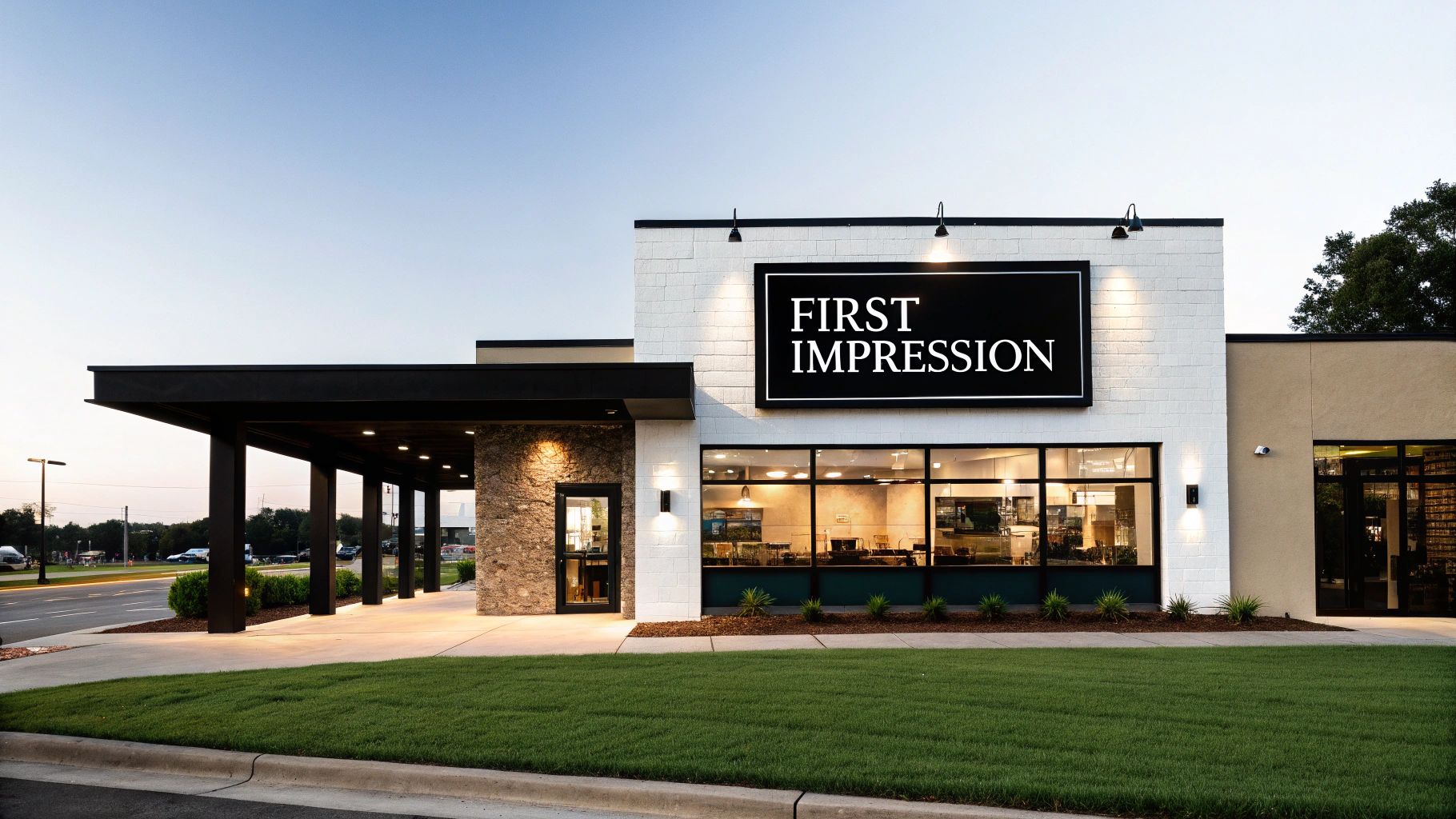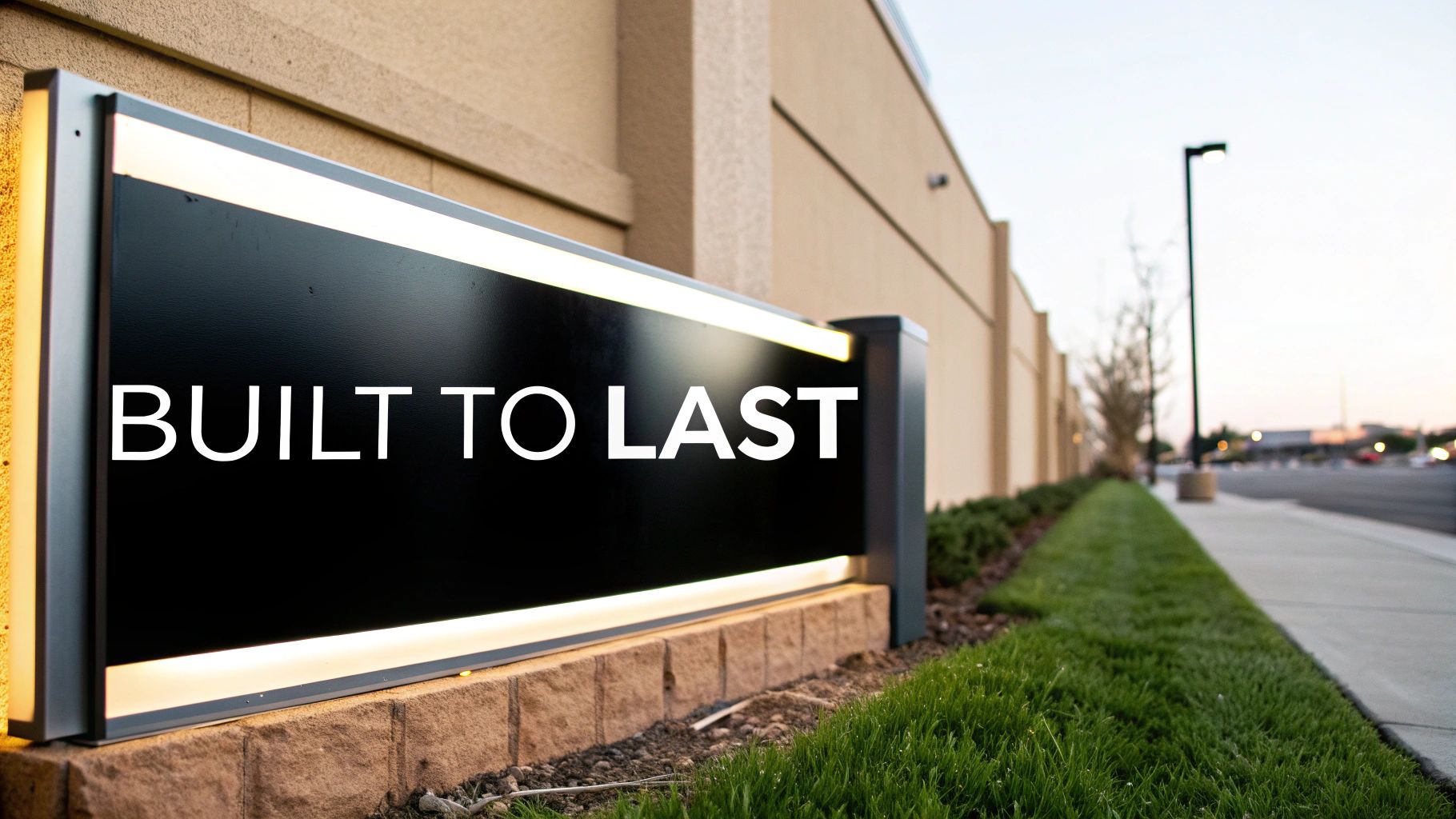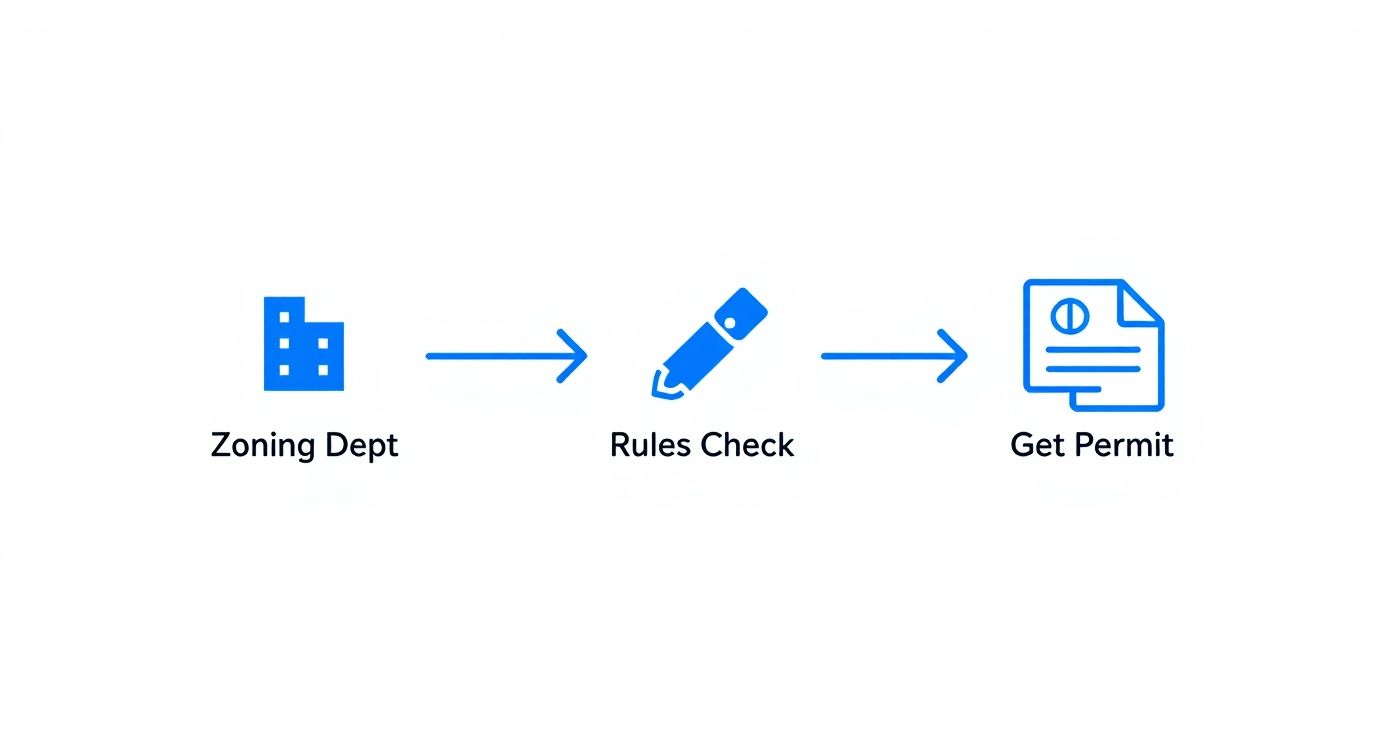
How to Crimp Wires to Connectors: Fast, Safe Tips
At its core, crimping is about creating a rock-solid mechanical bond without a single drop of solder. You're stripping the wire, sliding it into a

The right restaurant sign for outside does more than just display your name. It’s the single most important piece of marketing you own, acting as a silent salesperson that captures your brand’s personality, sets guest expectations, and drives foot traffic 24/7.
This sign is often the very first impression a potential diner has of your place. Before they smell the food or see a menu, your sign is already telling them a story—and influencing their decision to walk through your doors.

Think of your outdoor sign as the firm handshake that greets every person who walks or drives by. It’s much more than just a nameplate; it’s a constant billboard that frames the entire dining experience. Just like a book cover, it has to be compelling enough to make people curious about what’s inside.
The perfect sign instantly telegraphs your restaurant’s unique identity. Is your place an upscale bistro? A casual family diner? A lively pub? Your sign should answer that question at a glance, acting like a magnet for your ideal customers.
A thoughtfully designed sign isn’t just a landmark. It’s a beacon, guiding hungry patrons right to your door. This powerful visual cue is essential for a few key reasons:
An effective sign isn't an expense—it's a foundational investment in your brand's identity and profitability. It works tirelessly to turn sidewalk traffic into paying customers.
It's no surprise that the global signage industry, currently valued at USD 52.7 billion, is projected to soar to USD 97.3 billion. Businesses everywhere are waking up to the undeniable power of a strong first impression.
This guide is your roadmap. We’ll walk through everything you need to know, from sign types and materials to lighting and navigating local permits. And for a deeper dive into creating the perfect atmosphere, check out this great read on how restaurant lighting affects your customers.
Let’s make sure your first impression is a powerful—and profitable—one.

Picking the right restaurant signs for outside your building is a lot like plating the perfect dish. It needs to look incredible, set the right tone, and make people hungry for what you're offering inside. Every type of sign has its own unique flavor and function, directly shaping how potential customers see your brand from the curb.
Let's walk through the menu of signage options. The best choice always comes down to your building's design, your brand's personality, and, most importantly, the customers you want to bring through the door.
You see them everywhere on modern storefronts—those sharp, individual, three-dimensional letters. These are channel letters. Each letter is built separately and usually lit from within by LEDs, giving your restaurant's name a crisp, high-end look that’s impossible to miss.
They have a clean, sophisticated vibe that fits almost any concept, from a fast-casual spot to a fine-dining establishment. That 3D effect gives them a depth and premium feel that a flat sign just can't replicate, making sure your name pops, day or night.
Key Takeaway: For a polished, professional look with fantastic nighttime visibility, channel letters are a top-tier investment. They broadcast quality and permanence.
A blade sign, sometimes called a projecting sign, sticks out perpendicular to your building. Its entire job is to grab the attention of people walking down the sidewalk. If you're in a dense, walkable area like a downtown strip or a busy shopping plaza, this sign is non-negotiable.
Because it juts out into a person's direct line of sight, it cuts through the visual clutter of a busy street like nothing else. A well-designed blade sign can be the one thing that makes someone stop, look, and walk in, instead of just walking by.
Awning signs are a brilliant two-for-one deal. You get bold, can't-miss branding combined with the practical perk of giving your customers a little shelter from the sun or rain. Your name and logo are printed right onto the awning fabric, turning a simple architectural feature into a powerful marketing tool.
This style feels right at home for cafes, bistros, and delis aiming for that inviting, almost European feel. It physically extends your restaurant's presence onto the sidewalk, creating a warm, welcoming zone that practically begs people to come inside.
A monument sign is a freestanding structure, low to the ground, usually built near the entrance to your property. They’re often made from materials like brick, stone, or concrete to echo the building's architecture, and they give off a feeling of stability, permanence, and class.
These are perfect for restaurants set back from the road, tucked away in a larger complex, or for upscale places wanting to make an elegant first impression. A monument sign acts as a landmark, guiding drivers in and setting a sophisticated tone before they even park.
When your number one goal is being seen from a long way off, nothing comes close to a pylon sign. These are the tall, pole-mounted giants you see along highways and major roads. Their height lets them tower over nearby buildings and trees, making you visible to fast-moving cars from a distance.
Pylon signs are absolutely essential for any restaurant that depends on driver traffic—think diners, fast-food spots, or any place near a major artery. They're a beacon, giving drivers plenty of time to see you, make the decision to stop, and safely pull off the road. Many now include dynamic screens; you can get a better sense of these by exploring options for digital outdoor signage.
To give you a clearer picture, here’s a quick comparison of how these common sign types stack up for a restaurant.
| Sign Type | Primary Visibility | Typical Cost | Best For |
|---|---|---|---|
| Channel Letters | Building Facade (Day/Night) | High | Professional, modern storefronts needing 24/7 visibility. |
| Blade Sign | Pedestrian (Sidewalk Traffic) | Moderate | Restaurants in dense, walkable urban areas or shopping districts. |
| Awning Sign | Building Facade & Sidewalk | Moderate | Cafes, bistros, and delis wanting a charming, classic, and inviting look. |
| Monument Sign | Property Entrance (Drivers) | High | Locations set back from the road; upscale or fine-dining establishments. |
| Pylon Sign | Highway (Long-Distance) | Very High | Restaurants depending on traffic from major roadways and highways. |
This table is just a starting point, of course. The best solution for your restaurant might even be a combination of a few of these. A pylon sign to grab highway traffic, for instance, paired with a welcoming awning sign at the front door.
And don't forget the ground game. For immediate, up-close engagement, a great A-frame is your best friend. These portable sidewalk signs are perfect for shouting out daily specials, happy hour deals, or just a clever message to make passersby smile—and stop.
While traditional signs lay the foundation for your restaurant's identity, digital and LED signs are what truly steal the show. This technology turns your storefront from a static piece of branding into a dynamic, active marketing powerhouse. Think of it as your own personal billboard, working around the clock to grab attention and pull customers through your door.
Unlike a printed sign, a digital display is a living canvas. You can show off vibrant, mouth-watering videos of your signature dishes, announce tonight's happy hour special, or promote an upcoming event with animations that are impossible to ignore. This ability to change your message on a dime is an absolute game-changer for restaurant marketing.
One of the biggest wins with modern LED technology is its incredible brightness. These signs are engineered to cut right through the harshest daytime sun and shine brilliantly long after dark, making sure your message is always sharp and readable. Forget the faint glow of old-school neon; today's LEDs command attention from a serious distance.
On top of that, they're remarkably energy-efficient. An LED sign sips a fraction of the power required by older illuminated signs, which translates directly into lower monthly utility bills. That blend of superior performance and lower operating costs makes them a smart long-term investment.
The proof is in the numbers. The global digital signage market in Quick Service Restaurants (QSRs) was valued at USD 3.3 billion and is projected to skyrocket to USD 12.78 billion. This explosion is fueled by the need for better operational efficiency and a more engaging customer experience. You can learn more about the trends in the QSR digital signage market to see exactly where the industry is headed.
The real magic of digital restaurant signs for outside is their strategic flexibility. Your marketing can adapt to the time of day, the weather, or even what you have too much of in the kitchen. This opens up a whole new playbook of marketing tactics.
A static sign tells people who you are. A digital sign tells people what you want them to do right now. It turns passive lookers into active customers.
This instant control lets you test offers, react to what your competitors are doing, and directly influence customer behavior in ways that were impossible before. You can change your sign's content from a computer or even a smartphone in just a few minutes, with no need to call a sign company. For a deeper dive into how this technology can work for you, check out our comprehensive guide on LED signs for businesses.
Beyond just advertising, digital signs elevate the entire customer experience. They can display community messages, wish your customers a happy holiday, or even show live sports scores to build a real connection with passersby. This kind of engagement helps build brand loyalty and can make your restaurant a memorable local landmark.
By displaying incredible food videography, you appeal directly to a customer's appetite, making the decision to stop in almost irresistible. This visual storytelling is something a static sign simply can't do. In a world drowning in advertising, a bright, moving, and relevant message is the ultimate way to stand out.

A great sign is built to last and designed to shine. Seriously. The difference between a sign that looks fantastic for a decade and one that fades, cracks, and fails in a few years comes down to the materials and lighting you choose.
Think of it as an investment in your brand’s first impression. Skimping now means paying for costly repairs or an embarrassing, worn-out sign later. By choosing wisely from the start, you protect that investment and ensure your restaurant looks sharp, day or night, rain or shine.
Your sign's materials are its first line of defense against the elements. They have to stand up to everything your local climate can throw at them—scorching sun, pounding rain, freezing ice, or even salty sea air.
Each material offers a different mix of durability, looks, and cost. Here’s a breakdown of the most common choices for restaurant signs for outside:
The demand for high-quality, long-lasting signage is booming. The global outdoor printed signage market was valued at around USD 34.65 billion and is on track to hit USD 57.09 billion as technology keeps pushing what’s possible. Discover more insights about the outdoor signage market to see how this trend is shaping the way businesses think about branding.
Key Takeaway: Always match your material to your climate. Aluminum is a lifesaver in coastal areas with salt air, while HDU is a much smarter choice than wood in places with wild temperature swings.
Without light, your sign clocks out when the sun goes down. Proper illumination turns your sign into a 24/7 marketing machine, making sure your restaurant is visible and inviting long after dark.
You’ve got a few options, and each one impacts your sign's visibility, operating cost, and overall vibe.
First, you could go with a non-illuminated sign. It’s the most budget-friendly option, but it relies completely on ambient light. It’s basically invisible at night unless you already have fantastic external landscape lighting pointed right at it.
Next up are externally lit signs. These use spotlights or floodlights aimed at the sign face. This approach can create a dramatic, classic look, but it’s tricky to get right. Poorly placed lights can create distracting shadows or uneven "hot spots" on your sign.
Finally, you have internally lit signs, which are the modern standard for restaurants. This is where the light source—almost always LED these days—is placed inside the sign itself, like in channel letters or a lightbox. This method gives you the brightest, most even, and most professional-looking glow.
Today, LED (Light Emitting Diode) technology is the undisputed king of sign lighting. It has left older options like neon and fluorescent tubes in the dust for a few very good reasons:
When you pair durable, climate-appropriate materials with efficient LED illumination, you’re not just buying a sign. You’re building a powerful, long-lasting marketing tool that works around the clock to bring customers through your door.
It’s easy to get swept up in the excitement of designing a beautiful new sign for your restaurant. But hold on. Before you fall in love with a design or sign a check, there’s a critical step you absolutely cannot skip: understanding your local rules.
Think of it this way: the permitting process is the foundation you build your sign on. Skipping it is like building a house on sand. It might look great for a minute, but it's guaranteed to cause a world of expensive, frustrating problems down the road.
It’s to the zoning department. Seriously. Your very first move should be to get on the phone with your city or county’s local zoning or planning office. These are the gatekeepers for all things related to restaurant signs for outside, and they hold the rulebook that dictates exactly what you can and can't do.
Getting in touch with them early stops you from wasting time and money designing a sign that’s dead on arrival. This isn't just a formality; it's a crucial fact-finding mission.
Here’s exactly what you need to ask them:
Once you've got the basics down, the next layer of rules usually deals with lighting and location. Municipalities get pretty specific about how signs are lit to prevent distracting drivers and to maintain the character of a neighborhood.
You’ll often run into rules that limit brightness (measured in nits or lumens) or completely ban flashing, blinking, or animated lighting—especially for signs that aren't digital message centers.
A sign that violates local ordinances isn't just a compliance issue; it’s a wasted investment. A rejected permit can force you to redesign or completely scrap an expensive sign, turning an asset into a liability.
Your restaurant's location might also put it under another layer of oversight. Keep an eye out for special rules if your business is in a:
Beyond all the legal codes and official paperwork, there’s a simple, practical rule that every restaurant owner needs to live by: your sign has to be readable. A sign that checks every box on the permit application but is a blurry mess to potential customers is a complete failure.
There’s a great rule of thumb the sign industry has used for years: the “1-inch for 10-feet” rule. It’s simple: for every 10 feet of viewing distance, your letters need to be at least one inch tall.
Putting It to Work
Let's say you want drivers 100 feet away to clearly read your restaurant's name. According to the rule, your letters need to be a minimum of 10 inches high. If that distance is 200 feet, you’ll need 20-inch letters. This easy formula ensures your investment actually does its one, most important job: getting customers in the door.
Picking out the right restaurant signs for outside is a massive decision. This isn't just another purchase; it's an investment that will literally define how the public sees your brand for years. To get it right, you need a clear game plan that breaks a complicated process down into simple, logical steps. This framework will walk you from the first "what if?" to the final purchase.
First things first: define your goals and your budget. What's the number one job you need this sign to do? Is it to scream for attention from cars speeding down the highway? Or is it to gently charm pedestrians strolling past your front door? Answering that one question will instantly narrow your options and make sure you put your money where it'll work hardest for you.
Before you fall in love with a design, go outside. Stand across the street. Walk down the block and look back. Drive toward your restaurant from both directions. Seriously, do it.
What are the sightlines really like? Are there sneaky trees, utility poles, or the corner of another building in the way? This simple five-minute exercise gives you mission-critical intel on placement and size.
Now, scope out your neighbors' signs. What colors are they using? Are they lit up? The goal here isn't to blend in; it's to stand out. If everyone on your block has a warm, fuzzy backlit sign, a crisp, bright LED sign could be the very thing that makes you pop.
Okay, with your goals defined and your location scouted, you can zero in on the perfect sign type. As we’ve talked about, a massive pylon sign is a non-negotiable for highway visibility, while a classy blade sign is perfect for a walkable downtown strip. It's all about matching the sign’s function to where your customers are coming from.
Next up, materials. This is a choice based on both your climate and your brand's vibe. A sleek, modern restaurant might go for clean aluminum and acrylic channel letters. A down-home BBQ joint, on the other hand, might lean into a classic HDU sign that looks just like carved wood but won't rot. Your materials should shout your brand's personality from the rooftops while being tough enough to last.
This flowchart boils down the very first legal step: squaring things away with the local authorities to get your permit.

As you can see, getting that permit is a sequence. You have to understand the local zoning rules before you can even think about filling out an application.
When it comes to design, legibility is king. End of story. Use clean, easy-to-read fonts and colors that have high contrast. Don't forget the "1-inch for 10-feet" rule of thumb—it’s your best friend for making sure your letters are big enough to be read from a distance. Keep the message dead simple. Your name and logo are usually all you need. A cluttered sign is an invisible sign.
Finally, where do you actually buy this thing? You've got two main routes:
Final Thought: Choosing a sign isn't just about making things look pretty; it's a strategic marketing move. By following a logical process—setting goals, checking out your location, picking the right type, and finding a vendor you trust—you transform a major expense into one of your restaurant's most powerful assets.
Of course. Here is the rewritten section, crafted to sound like it was written by an experienced human expert, following all your specific instructions and style examples.
Making the jump to a new outdoor sign is a big move. It’s a serious investment, and you want to get it right the first time. To help clear things up, let's tackle some of the most common questions restaurant owners have when they're ready to make a change.
This is the million-dollar question, isn't it? The truth is, costs are all over the map depending on what you’re after. A simple, non-lit sign might run you a few thousand dollars, but that's just the starting point.
When you get into custom-illuminated channel letters or a slick monument sign, you're typically looking at a range of $5,000 to $15,000. If you're ready to step up to a dynamic digital LED sign that can change with your daily specials, expect that investment to start around $10,000 and go up from there based on size and clarity. Always get a few quotes, and don't forget to budget for permits and professional installation—they're part of the total cost.
The lifespan of your sign really comes down to two things: what it’s made of and the weather it has to put up with. A quality sign built with durable aluminum, tough acrylic, and modern LED lighting should easily give you 10 to 15 years of service, as long as you take care of it.
Materials like High-Density Urethane (HDU) are also built to last for the long haul. The secret to getting the most out of your investment is simple, regular maintenance. A little cleaning and a quick inspection now and then will keep your sign looking sharp and working perfectly for years.
A Quick Word of Warning: Don't even think about a DIY installation, especially for an illuminated sign. It's often illegal, and for good reason. Professional installers are licensed and insured. They know the structural and electrical codes inside and out, ensuring your sign is safe, secure, and up to spec. Trying to do it yourself can void your warranty and create a serious safety hazard for your customers and your business.
Ready to make a first impression that pulls in customers 24/7? At Smart LED Inc., we are the factory-direct source for brilliant, durable outdoor LED signs that make your restaurant impossible to miss. Skip the middleman and get an expert consultation by visiting us at https://smartledinc.com today.

At its core, crimping is about creating a rock-solid mechanical bond without a single drop of solder. You're stripping the wire, sliding it into a

So, what does a video wall actually cost? The honest answer is, it depends. A realistic budget can start around $15,000 for a straightforward indoor

The right restaurant sign for outside does more than just display your name. It’s the single most important piece of marketing you own, acting as
"*" indicates required fields